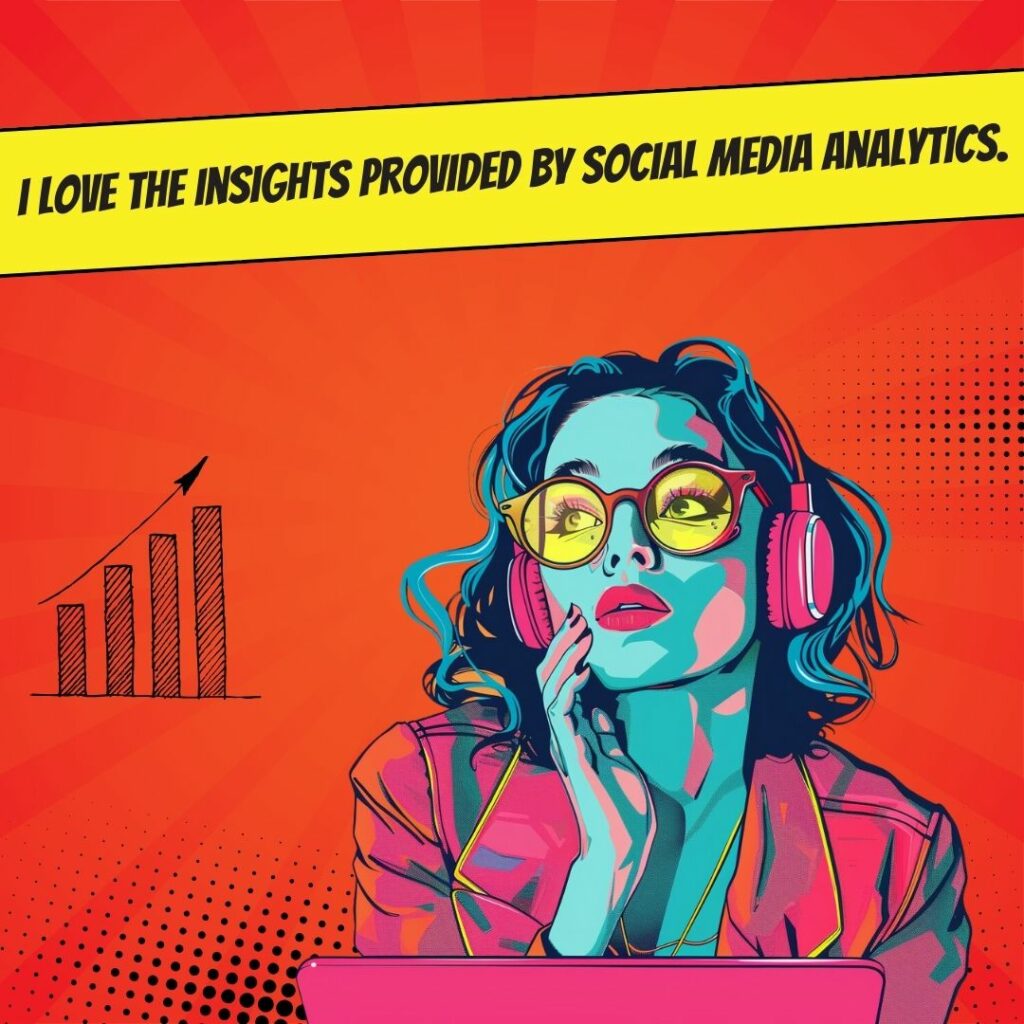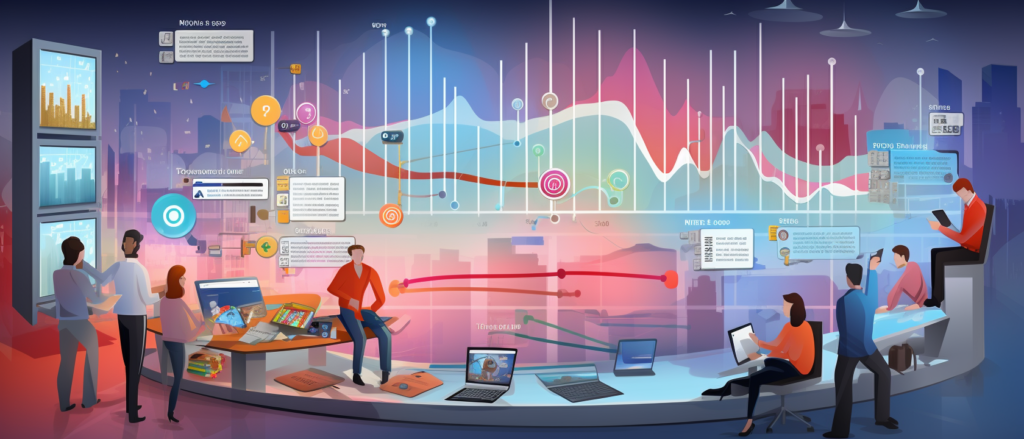Key Takeaways
✅ Data-Driven Insights: Social media analytics unlocks a treasure trove of data-driven insights, empowering you to tailor content, refine strategies, and understand your target audience with precision.
✅ Measuring Performance: Equip yourself with the power to measure and track progress against goals, optimizing campaign ROIs, and streamlining social strategies for stellar outcomes.
✅ Identifying Trends & Opportunities: Stay at the industry’s cutting edge by spotting trends and opportunities through social listening, propelling your brand to the forefront of the digital arena.
Introduction
Imagine harnessing the full power of Social Media Analytics to take your brand to new heights. In a digital ecosystem where every click, like, and share can translate into actionable insights, are you utilizing these golden nuggets of data to drive your brand’s growth?
In this eye-opening piece, we unravel the intricacies of social media analytics, guiding you through a voyage of digital empowerment. You’ll learn to set concrete objectives, select metrics that matter, and leverage cutting-edge tools designed to transform raw data into a strategic asset.
As we navigate through modern trends and innovative perspectives, we’ll spotlight success stories that have revolutionized revenue streams and ROAS using data at their core. Prepare to unlock groundbreaking information and actionable insights that promise not just to inform but also transform your marketing playbook. With our expert guidance, the secrets to maximizing your ROI with social media analytics are within reach. Join us in decoding the analytics puzzle, and let’s lead your brand to its zenith together.
Top Statistics
| Statistic | Insight |
|---|---|
| Social Media Analytics Market Value | The market size of $3.7 billion in 2020, forecasted to reach $15.6 billion by 2028, indicates a significant opportunity for growth for companies that leverage social analytics tools. |
| Social Media Users on Facebook | With Facebook having 2.8 billion monthly active users, it remains an invaluable platform for targeted marketing and user engagement strategies. |
| Key Instagram Demographic | The prevalence of users between the ages of 25 and 34 on Instagram points to the platform’s importance for reaching a young and active consumer base. |
| Investment in AI and ML | Given that 53% of companies plan to increase their investment, incorporating Artificial Intelligence (AI) and Machine Learning (ML) into social media analytics is crucial for strategic differentiation and advanced consumer insights. |
| Real-Time Analytics Demand | The fact that 45% of marketers seek real-time analytics underlines the need for businesses to adopt agile and responsive analytics platforms for timely decision-making. |
Setting Goals and Objectives
To unlock the full potential of social media analytics, your brand must first define its core objectives, such as enhancing engagement or expanding your follower base. These metrics should be tightly coupled with your overall marketing strategies to create a cohesive campaign. Adopting SMART goals will provide a robust framework for tracking success and driving growth.
Choosing the Right Metrics
Opting for the appropriate metrics is essential in social media analytics. Factors like engagement rates, follower demographics, and impressions provide insights into brand resonance. Meanwhile, metrics such as CTR and conversion rates can be directly tied to ROI. Conducting sentiment analysis and reviewing customer feedback are equally critical to comprehend your audience’s perception.
Tools and Platforms for Data Collection
Proper tools are the linchpin in capturing accurate social media analytics. Using native insights tools like Facebook Insights and Twitter Analytics will get you started, but integrating third-party platforms such as Hootsuite and Sprout Social can broaden your analysis. Additionally, implementing web analytics with services like Google Analytics can enrich your data ecosystem.
Interpreting and Visualizing Data
The interpretation phase is where data is translated into actionable insights. Identifying trends and patterns is critical for strategic planning. Employing visual aids like charts, dashboards, and segmented data can illuminate hidden insights, enabling a deeper understanding of your brand’s social media performance.
Applying Insights to Inform Strategic Decisions
Armed with this analytical acumen, your brand can then fine-tune its content strategy, tailor publishing schedules, and adapt target demographics to fortify your position in the market. Refined advertising strategies and budget allocations become clearer with these metrics in hand. Responsively monitoring customer feedback helps maintain a dialogue and enhances customer relations.
Inspirational Quotes
1. “Social media analytics is not just about measuring likes and shares; it’s about understanding your audience’s behavior and using those insights to create meaningful connections.”
– Rand Fishkin, Co-founder & CEO of SparkToro
2. “The future of social media analytics is not just about data, but about the ability to translate that data into insights, and those insights into action.”
– Jeremiah Owyang, Founder of Crowd Companies
3. “Social media analytics is not just about measuring your success; it’s about improving your strategy, engaging your audience, and growing your business.”
– Jay Baer, Founder of Convince & Convert
AI Marketing Engineers Recommendation
Recommendation 1: Harness User-Generated Content for Authentic Engagement: Leverage social media analytics to identify and promote user-generated content (UGC) that resonates with your audience. Analyzing engagement metrics can reveal which UGC posts drive the most interaction. For example, a recent report indicates that UGC has a 28% higher engagement rate than standard brand posts. Capitalize on this by using analytics to curate and share content that aligns with your brand values and speaks directly to your customer base.
Recommendation 2: Optimize Posting Times Using Behavioral Analysis: Delve into analytics to uncover when your audience is most active and likely to engage. Each social platform has distinct peak usage times. For instance, studies suggest that the best time to post on Instagram is typically on weekdays between 10 AM and 3 PM. By strategically timing your posts to coincide with these high-engagement windows, you can significantly increase visibility and interaction. Stay ahead by analyzing trends and adjusting your strategy accordingly.
Recommendation 3: Implement AI-Powered Social Listening Tools: Embrace tools like Brandwatch or Sprout Social, which employ AI to monitor social conversations and sentiment around your brand in real-time. These platforms offer deep insights into consumer behavior, competitive analysis, and emerging trends. By effectively utilizing these tools, you’ll achieve a holistic view of your brand’s social presence, enabling you to swiftly respond to opportunities or address potential crises, thereby safeguarding your brand reputation and driving growth.
Conclusion
As we conclude this deep dive into the empowering world of Social Media Analytics, it’s clear that the data harvested from these platforms is an invaluable asset for any brand striving to sharpen its edge in the digital arena. By meticulously setting goals, vigilantly choosing the right metrics, and adeptly employing robust tools for data collection, businesses can unveil the narrative their numbers are eager to tell. The transformative power of this data lends itself to crafting targeted strategies that communicate directly to the heart of the audience, optimizing engagement and amplifying the brand message distinctly across the buzzing channels of social media.
With the wealth of insights at your fingertips, analyzing and visualizing this data sheds a brilliant light on your path forward, fueling strategic decisions that keep your brand resonant and your content vibrant. As e-commerce mavens, adopting a mindset that celebrates data-driven decision-making is not just wise but essential in remaining agile and responsive to the constantly evolving consumer landscape.
Remember, the journey doesn’t culminate here. It is an ongoing cycle of learning, adapting, and innovating. Social Media Analytics is your compass in the complex topology of digital marketing, helping to navigate trends and sail towards significance in your market. Embrace these tools, leverage these insights, and let the tides of social data propel your brand towards new horizons of success and customer connectivity. Keep exploring, keep measuring, and most importantly, keep growing. Your next breakthrough is just a dataset away.
FAQs
Question 1: What is social media analytics?
Answer: Social media analytics refers to the process of collecting, analyzing, and interpreting data from various social media platforms to understand user behavior, sentiment, engagement, and other metrics related to brand performance.
Question 2: Why is social media analytics important?
Answer: Social media analytics is crucial because it helps businesses make informed decisions by understanding their audience better, optimizing marketing strategies, measuring the effectiveness of campaigns, and identifying areas for improvement.
Question 3: What are the key metrics to track in social media analytics?
Answer: Key metrics include engagement rate, reach, impressions, follower growth, click-through rate, conversion rate, and sentiment analysis. These metrics help businesses understand their social media performance and adjust their strategies accordingly.
Question 4: How can I measure the ROI of social media analytics?
Answer: Measuring ROI involves setting specific, measurable goals, tracking key metrics, and attributing revenue to social media activities. This can be done by using UTM parameters, tracking codes, and analyzing the impact of social media on website traffic and conversions.
Question 5: What are the best tools for social media analytics?
Answer: Popular social media analytics tools include Hootsuite, Sprout Social, Buffer, BuzzSumo, and Google Analytics. These tools provide insights into various metrics, help schedule and publish content, and track the performance of social media campaigns.
Question 6: How can I analyze sentiment on social media?
Answer: Sentiment analysis involves using natural language processing (NLP) algorithms to identify and categorize positive, negative, or neutral sentiment in social media posts. This can be done using tools like Brandwatch, MonkeyLearn, or by manually analyzing comments and feedback.
Question 7: How can I optimize my social media content for better engagement?
Answer: Optimizing social media content involves creating visually appealing and engaging posts, using relevant hashtags, posting at optimal times, and responding to comments and messages promptly. A/B testing can also help identify the most effective types of content for your audience.
Question 8: How can I use social media analytics to improve my marketing strategies?
Answer: Social media analytics can help identify your target audience, understand their preferences, and optimize your content and campaigns accordingly. Additionally, monitoring industry trends and competitor performance can help you stay ahead and make data-driven decisions.
Question 9: What is the role of influencer marketing in social media analytics?
Answer: Influencer marketing involves partnering with individuals who have a large following on social media to promote your brand. Analyzing the impact of influencers on your brand’s performance can help you identify the most effective partnerships and optimize your influencer marketing strategy.
Question 10: How can I integrate social media analytics with other marketing channels?
Answer: Integrating social media analytics with other marketing channels involves tracking cross-channel performance, analyzing the impact of social media on other marketing activities, and using data from social media analytics to inform strategies across all marketing channels. This can be done using tools like Google Analytics and marketing automation platforms.
Academic References
- Wasserman, S., & Faust, K. (1994). Social Network Analysis: Methods and Applications. Cambridge: Cambridge University Press. This comprehensive text offers a deep dive into the methodology behind social network analysis and its diverse applications, placing a significant emphasis on interpreting the intricate web of relationships in online communities, particularly relevant to social media platforms.
- Berryman, M. G., Angus, D., Poot, A., Robin, G., & McHugh, I. (2006). Mining Social Networks for Terrorism Investigations. IEEE Intelligent Systems, 21(6), 18-25. This thought-provoking article explores the application of social network analytics in identifying and thwarting potential terrorist threats by analyzing patterns of interactions within social media networks, offering a critical edge in security protocols.
- Aral, S., & Walker, D. (2010). The Structure and Dynamics of Online Diffusion Networks. Management Science, 56(6), 2159-2171. In this insightful study, Aral and Walker investigate the pathways through which information proliferates across social media networks, revealing patterns of virality, influence, and user engagement that are essential for marketers to finesse their digital strategies.
- Liu, B. (2012). Social Media Analytics and Intelligence. Heidelberg: Springer. Liu’s book offers an extensive exploration into the realm of social media analytics, detailing an array of technical approaches and algorithms particularly for sentiment analysis, topic modeling, and network analysis, which can mine rich insights from social media chatter.
- Knoke, D., & Yang, S. (2018). Social Network Analysis in Applied Settings. Thousand Oaks, CA: Sage Publications. This practical guide centers around the real-world application of social network analysis, with Knoke and Yang presenting intriguing case studies across various industries such healthcare, marketing, and politics, illustrating the impactful utilization of social network insights.













